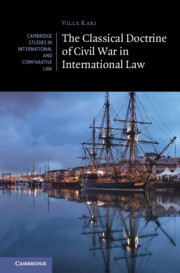Refine search
Actions for selected content:
615759 results in History
The Cambridge History of International Law
- Coming soon
-
- Expected online publication date:
- April 2026
- Print publication:
- 30 April 2026
-
- Book
- Export citation
Iran's Minorities
- Social Diversity and State Power
- Coming soon
-
- Expected online publication date:
- April 2026
- Print publication:
- 30 April 2026
-
- Book
- Export citation
The Rebirth of the Spanish Empire
- War and Sacred Kingship in Early Bourbon Mexico
- Coming soon
-
- Expected online publication date:
- April 2026
- Print publication:
- 30 April 2026
-
- Book
- Export citation
Abul A‘la Maududi: Al Jihad fil Islam and Other Writings
- Coming soon
-
- Expected online publication date:
- April 2026
- Print publication:
- 30 April 2026
-
- Book
- Export citation
Concubines in Public
- The Rise of the Social Wife in Republican China
- Coming soon
-
- Expected online publication date:
- April 2026
- Print publication:
- 30 April 2026
-
- Book
- Export citation

The Cambridge History of Music in Spain
- Coming soon
-
- Expected online publication date:
- April 2026
- Print publication:
- 30 April 2026
-
- Book
- Export citation
The Inner Life of Politics
- Grassroots Activism in West Germany, 1962–1983
- Coming soon
-
- Expected online publication date:
- April 2026
- Print publication:
- 30 April 2026
-
- Book
- Export citation
European Shiʿism
- Peripheral Engagement and Religious Retention
- Coming soon
-
- Expected online publication date:
- April 2026
- Print publication:
- 30 April 2026
-
- Book
- Export citation
Piratical States
- British Imperialism in the Indian Ocean World, c.1780–1850
- Coming soon
-
- Expected online publication date:
- April 2026
- Print publication:
- 30 April 2026
-
- Book
- Export citation
The Cambridge History of American Popular Culture
- Coming soon
-
- Expected online publication date:
- April 2026
- Print publication:
- 01 May 2027
-
- Book
- Export citation
Knowing Ethnicity
- The Politics of Classification and Pluralism in Kenya
- Coming soon
-
- Expected online publication date:
- April 2026
- Print publication:
- 30 April 2026
-
- Book
- Export citation
The Politics of Nature in Nazi Germany
- Environmental Ideals and the Myth of Blood and Soil
- Coming soon
-
- Expected online publication date:
- April 2026
- Print publication:
- 30 April 2026
-
- Book
- Export citation

The Cambridge Companion to the Byzantine Church
- Coming soon
-
- Expected online publication date:
- April 2026
- Print publication:
- 30 April 2026
-
- Book
- Export citation

Life, Death, and Migration in the Early Modern City
- The Urban Historical Demography of Würzburg
- Coming soon
-
- Expected online publication date:
- April 2026
- Print publication:
- 30 April 2026
-
- Book
- Export citation
Urban Revolution
- People's Communes in Beijing
- Coming soon
-
- Expected online publication date:
- April 2026
- Print publication:
- 30 April 2026
-
- Book
- Export citation

Boundaries of Belonging
- Sectarianism and Statecraft in the Early Modern Ottoman Empire
- Coming soon
-
- Expected online publication date:
- April 2026
- Print publication:
- 30 April 2026
-
- Book
- Export citation
Soviet Jews under Late Stalinism
- A Story from the Western Borderlands
- Coming soon
-
- Expected online publication date:
- April 2026
- Print publication:
- 30 April 2026
-
- Book
- Export citation

The Astronomy of Hipparchus
- An Annotated Translation of and Introduction to the Commentary on the Phenomena of Aratus and Eudoxus
- Coming soon
-
- Expected online publication date:
- April 2026
- Print publication:
- 30 April 2026
-
- Book
- Export citation

Tipping Out of Trouble
- How Societies Transformed and How We Can Do So Again
- Coming soon
-
- Expected online publication date:
- April 2026
- Print publication:
- 02 April 2026
-
- Book
- Export citation

The Classical Doctrine of Civil War in International Law
- Coming soon
-
- Expected online publication date:
- April 2026
- Print publication:
- 30 April 2026
-
- Book
- Export citation
